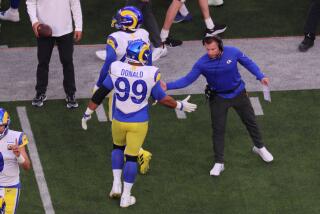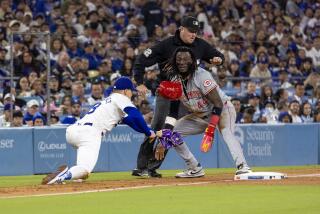Reds Rejuvenate Mariano Duncan
- Share via
CINCINNATI — Clearer of mind and stronger of body than when he was with the Dodgers, Mariano Duncan is playing a key role in the revitalization of the Cincinnati Reds.
“When you go from an organization that doesn’t treat you right to an organization that does, you have to be happy,” Duncan said. “I feel like I am in my house.”
Though a long way from the Dominican Republic, Duncan means that he feels at home with the Reds.
And he has been performing like it.
Playing regularly at second base, the choice of Manager Lou Piniella over veteran Ron Oester, Duncan continues to be among the National League’s batting leaders.
A .235 career hitter, Duncan ended April with a league-leading average of .409. He was also first in slugging, at .776, and second in getting on base, at .483.
He is second among the Reds in runs batted in with 14 and has four home runs in 65 at-bats, one more than his total in 248 at-bats last year.
Duncan, 27, credits a variety of factors, among them:
--The addition of 12 pounds in upper-body muscle since last season ended. At 6 feet, he now weighs 192 pounds.
--Batting tips from Piniella and coach Tony Perez.
--The experience and maturity gained in five major league seasons, combined with the opportunity to play regularly for the first time since 1985, when he was in 142 games, primarily as the Dodger shortstop.
“I’m a lot more relaxed now,” he said. “I know that if I go hitless, I’ll get another chance.
“I’ve played long enough that I know what’s good for me and what isn’t. I know what to expect and what not to expect.”
Duncan created promising expectations in ‘85, when he opened the season as the Dodger second baseman because of an injury to Steve Sax, then moved to shortstop because of an injury to Dave Anderson.
He finished third in rookie-of-the-year balloting, batting .244 with 24 doubles and 38 stolen bases. He made 30 errors but played so spectacularly at times that coach Monte Basgall said, “He out-Ozzies Ozzie (Smith).”
Duncan came back to steal 48 bases in 1986, but injuries restricted his availability to 109 games, in which he batted .229.
Torn knee cartilage wiped out 1987, by which time management was developing concerns that his close relationship with Pedro Guerrero wasn’t providing the desired leadership.
Then, in the spring of 1988, after being optioned to Albuquerque, Duncan publicly called Manager Tom Lasorda a liar, saying Lasorda had promised him, in a meeting also attended by his coaches, he would open the season with the Dodgers.
“Tommy never forgives or forgets,” Duncan said the other day. “I don’t want to say anything bad about him now because he gave me the chance to play in the big leagues, but that (calling him a liar) was the reason I was traded.”
The deal last July 18 sent Duncan and Tim Leary to the Reds for Kal Daniels and Lenny Harris.
A dream come true, Duncan said.
“Not many guys get a second chance,” he added. “I’m one of the lucky ones. I mean, one day I’m in the Dodger doghouse, the next day I’m in the Reds’ lineup. I was the happiest man in the world.”
In 1989, with Cincinnati shortstop Barry Larkin sidelined by an injury suffered in the skills contest at the All-Star game, Duncan played shortstop during most of a dispiriting second half in which injuries and the ongoing travails of then-manager Pete Rose took the Reds out of contention.
He batted .247, but Piniella was attracted to his speed and potential and announced at the start of the 1990 abbreviated spring training that Duncan would start at second base, ahead of Oester. Oester had re-signed with the Reds in the winter of 1988-89 rather than accept a free-agent offer from the Dodgers when they were attempting to replace Sax.
“We’re not really a power club,” Piniella said the other day. “The more contact we make and the more speed we have on the bases, the more we can do.
“We’re a finesse club, and Duncan contributes to that.”
Said General Manager Bob Quinn, who replaced Murray Cook last winter: “When Lou and I were with the Yankees, we had talked to the Dodgers about trying to acquire Duncan before we signed Sax. We felt he had great tools that hadn’t been honed to the point they are now. We felt he might be a sleeping giant.”
Duncan said Piniella and Perez are responsible for changes in the position of his hands and weight at the plate, that they have given him a clearer perception of what he is looking for and trying to do.
“The biggest problem in Los Angeles was that there were so many people telling me what to do that I tried to listen to everyone and got confused,” he said. “There were always five or six people changing this or that, always someone contradicting what someone else had just told you. Here there’s only Lou or Tony and they are working together.
“The other thing was that the expectations in Los Angeles were so great after 1985 that I just wasn’t ready to handle the pressure. I’d just had a good year as a rookie and was expected to have a better year. I was only 22, playing in the big city, and I tried to do too much. It really slowed me down.”
Now, Duncan, who was initially batting eighth and has been moved up, sometimes as second, to compensate for the absence of injured Eric Davis, is only trying to make contact and use the entire field. Two of his four home runs have come on two-strike pitches when he was only trying to put the ball in play.
“He’s stronger than he looks and he has a quick bat,” Piniella said. “The ball tends to jump off it. A .300 hitter? I don’t want to put any expectations on him, but I would be surprised if he didn’t continue to have a productive season in every category.”
Duncan, who remains friends with the Guerreros and is dining at their St. Louis home this weekend, smiled and said it is a thrill to see his name at or near the top of the league’s batting list.
“I haven’t set a goal, but my dream is to hit .300,” he said. “From what I see, everything Tony and Lou says, works. I seem to improve with everything they teach me. I’m hitting the ball hard every time at the plate. With what I’m doing now, I think I can do it.”
More to Read
Go beyond the scoreboard
Get the latest on L.A.'s teams in the daily Sports Report newsletter.
You may occasionally receive promotional content from the Los Angeles Times.










